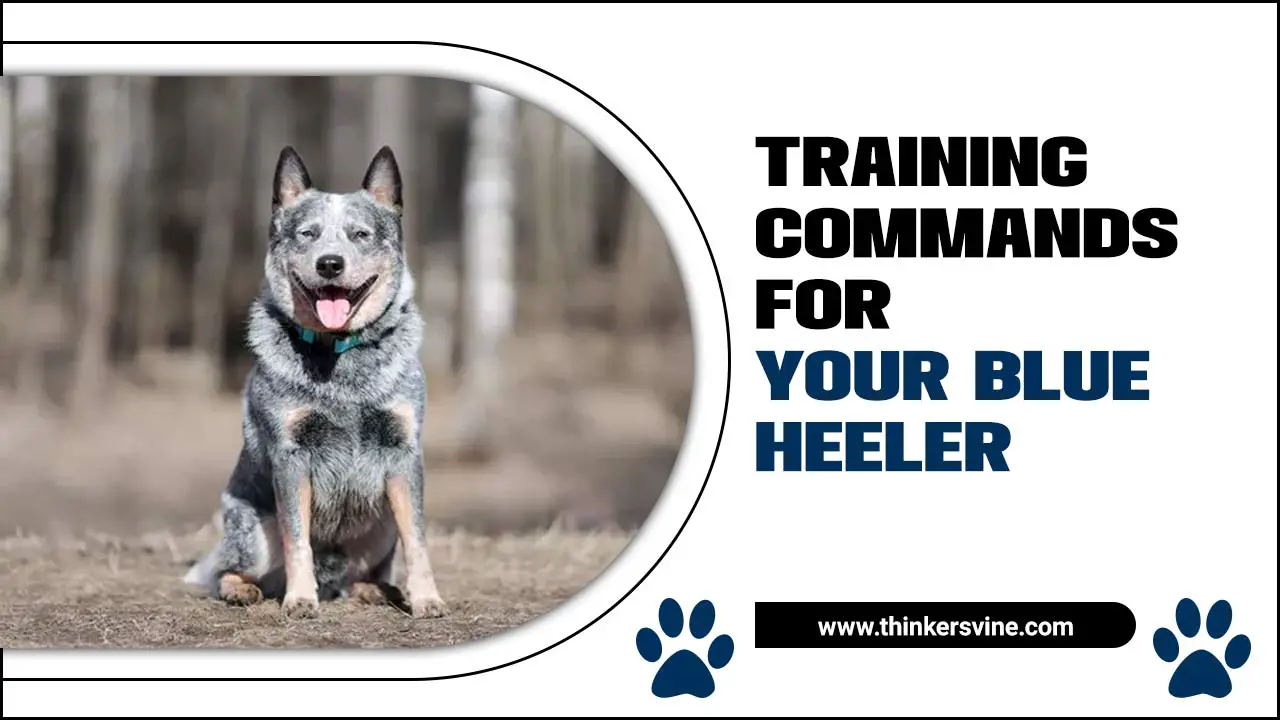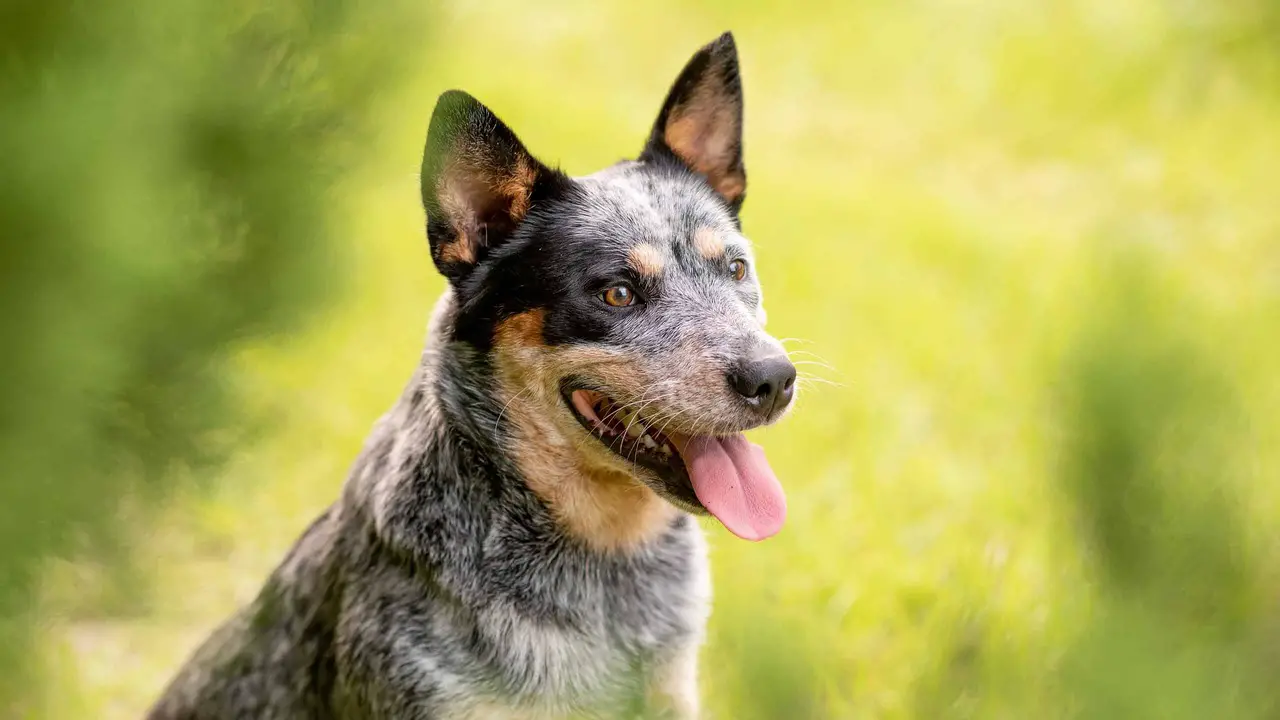Blue Heelers, also known as Australian Cattle Dogs, are a unique and intelligent dog breed. They were originally bred in Australia for herding cattle, and their natural instincts make them excellent working dogs.
Blue Heelers are known for their distinctive blue or red speckled coat and alert, energetic nature. They are incredibly loyal and protective of their families, making them great companions and watchdogs. These dogs thrive on mental and physical stimulation, requiring plenty of exercise and training to keep them happy and well-behaved.
Here we’ll provide a complete guide to essential training commands for your Blue Heeler. We’ll cover the basic commands such as sit, stay, come, and down, as well as more advanced commands such as heel, leave it, and drop it.

7 Essential Training Commands For Your Blue Heeler

Training your Blue Heeler is essential for their safety and well-being. Consistency and positive reinforcement are key when training your Blue Heeler. With patience and practice, they will become well-behaved companions who understand and respond to these essential commands. Here are 7 essential training commands for your Blue Heeler should know:
1. Stay
When training your Blue Heeler, the “Stay” command is an essential one to teach. This command helps to keep your dog in place and prevents them from wandering off or getting into potentially dangerous situations. Have them sit or lie down to train your Blue Heeler to stay. Then, step back and say “Stay” in a firm but calm voice.
If your dog stays in place, reward them with praise and a treat. Gradually increase the distance and duration of the stay command, always reinforcing with positive reinforcement. Your Blue Heeler will become a pro at the “Stay” command with practice and consistency.
2. Sit
Teaching your Blue Heeler to sit is an essential training command that will set the foundation for other commands and behaviors. Hold a treat close to your dog’s nose and slowly move it upwards, causing its head to follow the treat and its bottom to naturally lower. As soon as their bottom touches the ground, say “sit” and give them the treat as a reward. Repeat this process several times until they consistently sit when prompted. It’s important to be patient and consistent during training sessions, using positive reinforcement to encourage good behavior.
3. Wait
When training your Blue Heeler, teaching them to “wait” is essential. This command is useful in various situations, such as when you need your dog to stay put while you open the door or when you want them to wait before eating their food. To teach your Blue Heeler to wait, start by placing them in a sit or down position.
Then, give the command “wait” and take a step back. If your dog stays in place, reward them with praise and a treat. Gradually increase the distance and duration of the wait command, always rewarding your dog for their patience.
4. Down
Training your Blue Heeler to “down” is an essential command that can help promote obedience and discipline. Teaching your dog to lie down on command can be helpful in various situations, such as when you need them to stay calm or when you want to prevent jumping up on people. To teach your Blue Heeler to “down,” follow these steps:
- Find a quiet and distraction-free area for training.
- Start by getting your dog into the “sit” position.
- Hold a treat before their nose, then slowly bring it down towards the ground.
- As your dog follows the treat with their nose, their body will naturally lower into a lying down position.
- Once they are fully down, say the command “down” and give them the treat as a reward.
- Practice this command repeatedly, gradually phasing out treats but continuing to praise and reward your dog for successful “downs.”
5. Paws Off
Training commands are essential for teaching your Blue Heeler good behavior and ensuring their safety. “Paws off” is a particularly important command to teach your dog, as it can prevent them from getting into potentially dangerous situations.
To train the “paws off” command, hold a treat in your closed hand and present it to your dog. When they try to paw at your hand, say “paws off” firmly and withdraw your hand. Repeat this until your dog understands that “paws off” means they should not touch or paw at the object or person before them.
6. Leave It
Teaching your Blue Heeler the “Leave It” command is essential for their safety and well-being. This command teaches them to ignore certain objects or items that may be harmful or inappropriate for them to interact with. To train your Blue Heeler to “Leave It,” follow these steps:
- Start with a treat in your closed hand.
- Show your closed hand to your dog and say, “Leave It.”
- Wait for them to stop pawing or sniffing at your hand.
- When they back away or lose interest, praise and reward them with a different treat from your other hand.
- Repeat this process, gradually increasing the difficulty by placing the treat on the ground or introducing distractions.
- Practice “Leave It” in different environments and situations to reinforce the command.
7. Drop It
Teaching your Blue Heeler to “drop it” is an essential training command that can help keep them safe and prevent them from chewing or ingesting harmful objects. To train your Blue Heeler to drop items on command, follow these steps:
- Start with a toy or object your dog enjoys playing with.
- Hold the toy in one hand and let your dog take it in their mouth.
- Say “drop it” in a firm but calm tone.
- Gently open your dog’s mouth and remove the toy while repeating the command.
- Immediately reward your dog with praise and a treat for dropping the toy.
- Practice this command regularly, gradually increasing the difficulty by using different objects and in different environments.
Go To Bed
One essential training command for your Blue Heeler is “Go to Bed.” Teaching your dog this command can be helpful in various situations, such as when you need them to settle down or when it’s time to go to their designated sleeping area. To train your Blue Heeler to “Go to Bed,” follow these steps:
- Choose a designated bed or sleeping area for your dog.
- Use a treat or toy to lure your dog onto the bed or into the sleeping area.
- Use a verbal cue, such as “Go to Bed,” while your dog is on the bed.
- Reward your dog with praise and treats when they comply with the command.
- Practice the command regularly, gradually reducing the use of treats until your Blue Heeler responds reliably to the verbal cue alone.
Take It
When training your Blue Heeler dog, there are a few essential commands that you should focus on. One of the most important commands is “take it.” This command teaches your dog to gently take an object from your hand without biting or snatching. It is especially useful when you need to give your dog medication or when playing fetch.
To train your Blue Heeler to “take it,” start by holding a treat in your closed fist and letting your dog sniff and lick it. When they stop trying to bite or paw at your hand, say “take it” and open your hand to let them have the treat. Repeat this process several times until they understand the command.
Quiet
Several essential commands can help you establish a strong bond and ensure their safety when training your Blue Heeler. One of the most important commands is “quiet.” Blue Heelers are known for their vocal nature, so teaching them to be quiet on command can be incredibly valuable. To train this command, wait momentarily when your dog is barking or whining. Then, use a firm but calm voice to say “quiet” and wait for them to stop making noise.
Tips For Successfully Training Your Blue Heeler

Training a Blue Heeler can be a rewarding experience, but it does require patience and consistency. By following these tips and investing time in training your Blue Heeler, you can help ensure they grow to be well-behaved and obedient companions. Here are some tips for successfully training your Blue Heeler:
- Start early: It’s best to start training your Blue Heeler as early as possible. This breed is known for its intelligence and high energy levels, so early training will help establish good behaviors and prevent any potential behavior issues.
- Be consistent: Consistency is key when training a Blue Heeler. Use the same commands and cues consistently, and ensure everyone in the household is on the same page with training methods.
- Positive reinforcement: Blue Heelers respond well to positive reinforcement, so reward good behavior with treats, praise, and playtime. Avoid punishment-based training methods, as they can be counterproductive with this breed.
- Socialization: Blue Heelers are naturally protective, so it’s important to socialize them from an early age. Expose them to different people, animals, and environments to help them become well-adjusted and friendly.
- Mental stimulation: Blue Heelers are intelligent dogs that thrive on mental stimulation. Incorporate puzzle toys, obedience exercises, and interactive games into their daily routine to keep their minds engaged.
Conclusion
Essential training commands for your Blue Heeler are an important and necessary part of being a responsible dog owner. These commands, such as sit, stay, come, and heel, should be taught using positive reinforcement techniques and consistency. It’s important to remember that every dog is different and may require varying levels of training.
By following the tips and techniques outlined, you can ensure your dog is well-behaved and obedient and strengthen your bond with your furry friend. Remember to be patient, consistent, and positive in your training approach, and always prioritize your dog’s safety and well-being. Your Blue Heeler will become a well-trained and happy companion for years with time and effort.
FAQ
[rank_math_rich_snippet id=”s-abe22517-b174-4a04-aa09-bade3c542224″]